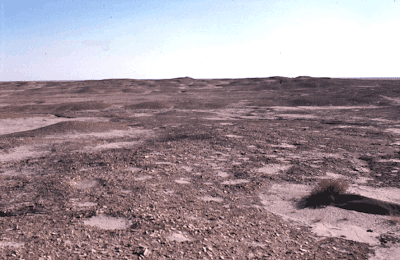Emmeduranki
[2], king of Sippar, is
the seventh of the aboriginal kings, and he declares that he received the
divine tablet “from Anu
[Bel, and Ea]."
Site of Sippar
Chinese
sages have their own interpretation of the phrase “the mystery of heaven
and earth.” They would at once associate the words “heaven” and “earth”
with the two opposing principles yang
and yin, and the question is whether among the ancient Sumerians there
was not a similar tendency prevalent. It seems not to be impossible that the Chinese tablet in the
hands of Fuh-Hi is the
same as the “Tablet of Destiny” of the Sumerians, and when some Assyriologist has
informed himself of the primitive Chinese conception of this mysterious tablet,
he may be able to throw some additional light on the subject." [3]
One of the dragons from The
Nine Dragons handscroll (九龙图/九龍圖),
painted by the Song-Dynasty Chinese artist Chen Rong (陈容/陳容) in
1244 CE. Ink and some red on paper.
[1] Fuh-Hi (伏羲), the mythical founder of Chinese civilization, who lived
from 2858 to 2738 B.C. The writers of Chinese history
tell us that the Emperor Fuh-hi was living in the time of Noah.
Fuh-Hi and his sister and consort Nuwa. Hanging scroll,
8th century AD (Tang Dynasty).
[2] En-men-dur-ana
(also Emmeduranki) of
Sippar was an ancient Sumerian king, whose name appears in the Sumerian King List as the
seventh and penultimate pre-dynastic king of Sumer (before ca. 2900 BC). His
name means "chief of the
powers of Dur-an-ki," while "Dur-an-ki" in turn means "the meeting-place of heaven and
earth" (literally "bond of above and below").
En-men-dur-ana's city Sippar was associated with the worship of the sun-god Utu, later called Shamash in
the Semitic language. Sumerian and Babylonian literature attributed the
founding of Sippar to Utu. A myth written in a Semitic language tells of
Emmeduranki subsequently being taken
to heaven by the gods Shamash and Adad, and taught the secrets
of heaven and of earth. In particular, Emmeduranki was taught arts of divination, such
as how to inspect oil on water and
how to discern messages in the
liver of animals and several other divine secrets. En-men-dur-ana was extremely
significant to the Sumerians, as he was the ancestor from whom all priests of the sun God had to
be able to trace descent.
Sumerian "cosmology map" derived from Tablet of
Destiny.
[3] At the Institute
of Fine Arts of New York University, I regularly sat in rapt
fascination in Professor
Donald Hansen’s lectures concerning the history of ancient Middle Eastern Art and also
in Professor Alexander Soper’s
Chinese Art classroom. Frequently I wish I
could return to the Institute and its sounds, moods and, especially, its views. (However, I do not miss the parades constantly going by – you wouldn’t believe how many – on Fifth Avenue. I hate parades and they're all, with the notable exceptions of Steuben Day and Pulaski Day, untidy and unruly beyond belief.) These esteemed scholars taught me much of
what was known then (and was still being discovered) about ancient trade routes and the remarkable influences geographically
remote parts of the ancient world exerted on each other. Could anything possibly be more interesting? The first part of this messy,
incoherent-seeming post is excerpted from Paul Carus’ excellent Chinese Astrology (LaSalle,
Open Court Press, 1907). Notes 1
and 2 above were assembled from other sources.
Someday, some way, I’d like to be able to make sense out of everything
that has always confused me and confuses me now.










Paul Carus was a very interesting figure. He had a comprehensive view of things that I think you would have enjoyed, even if you might not have agreed on the particulars. The Carus lecture series is the most prestigious one in American philosophy, but nowadays they rarely achieve anything like the breadth or depth or open-mindedness of their founder.
ReplyDelete"Someday, some way, I’d like to be able to make sense out of everything that has always confused me and confuses me now." This is a noble aspiration which I respectfully share.
Thanks. I remember reading biographical material (fascinating stuff) on Carus's life and career when I first dug into Chinese Astrology, which is a wonderful book that I found in my mother's library. I don't know whether you've ever seen the marvelous video Julian Temple directed for the terrific Kinks song, State of Confusion, but you can probably find it on youtube. That's sort of where I'm at currently. It happens. Hope Natty's concert was great. Did you stay over in CT? Curtis
ReplyDeleteI just learned about Paul Carus during my research for my book on The Evolution of The Divine Mother. I was looking for the correlation between the Tablets of Destiny and the I-Ching, and found correlation starting from the Ife Oracle to The Tablets of Destiny, to the I-Ching and the Oracle of Yaveh. I'm also inter-relating the stealing of the Tablets to the Dogon's stealing of the fire and to what the Patriarchs later made the Fall of Eve.
ReplyDeleteThanks for writing and please forgive my late reply. Life's been a little disordered lately. I'm glad you found this. Carus was a fascinating man. Hoping to reinvolve myself in this soon. Please visit again. Curtis
Delete